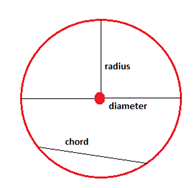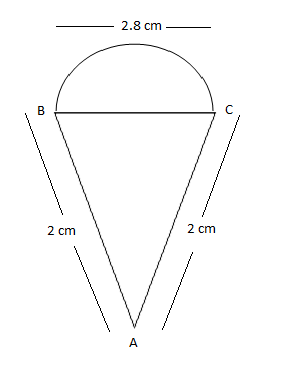8th Grade > Mathematics
MENSURATION MCQs
:
In the given figure, ∆AOB is right-angled triangle right angled at O.
So,
⇒ AO2 + OB2 = AB2.
⇒ 52 + OB2 = 132.
⇒ OB2 = 169 - 25 = 144
⇒ OB = 12cm
So now the total area of the hexagon = 4× Area of ∆AOB+ 2× Area of rectangle BCPO
⇒ Area = 4 × (12 × OB × AO) + 2 × (BC × OB)
⇒ Area = 4 × (12 × 12 × 5) + 2 × (13 × 12)
⇒ Area = 4 × (30) + 2 × (156)
⇒ Area = 432cm2.
:
A
First, we need to calculate the area of one carpet:
Area of one carpet = 8 × 6 = 48 m2.
Since total area of the floor of the hall = 1200 m2.
Therefore, number of carpets required = area of floorarea of one carpet = 120048 = 25.
:
B
Volume of Cylinder is given by: Vcylinder=π×radius2×height
Volume of Cube is given by: Vcube=edge3
Volume of Cube is given by Vcuboid=length×breadth×height
Therefore,
⇒Vcylinder=227×r2(2r)=447r3
⇒Vcube=(34r)3=2764r3
⇒Vcuboid=r×54r×73r=3512r3
Comparing the above volumes we get that Vcube < Vcuboid < Vcylinder
:
C
Let us assume the height and radius of the original cylinder is l and r respectively.
Let V1 be the original volume and V2 be the volume after the change in height and radius.
Therefore volume of the original cylinder is given by: V=πr2l
After, height of a cylinder becomes 18of the original height and the radius is doubled
We have, r2=2r and l2=l8
So the new volume is given by:
V2=πr22l2=π(2r)2(l8)
⇒V2=4πr2l8
⇒V2=πr2l2=V12
⇒V2=V12
Hence the volume of the cylinder will be halved.
:
A
Let the dimension of a cuboid be l, b, and h.
Since the six surface areas are given:
⇒ l × b = 12.......................................(1)
⇒ b × h = 36.......................................(2)
⇒ l × h = 48.......................................(3)
Now multiplying equation (1),(2) and (3), we get
⇒(l×b)×(b×h)×)(l×h)=12×36×48
⇒ (l×b×h)2=20736
⇒(l×b×h)=√20736 =144 cm3
Since volume of a cuboid is calculated as ′l×b×h′, the required volume is 144 cm3.
:
C
Volume of one small cuboid = l × b × h = 20cm × 25cm × 40cm
Since the edge length of the cubical box = 2 m = 200 cm
Now, Volume of the cubical box = 200cm×200cm×200cm
So the number of cuboids that can be just accommodated in the box = Volume of the cubical boxvolume of the cuboid.
⇒ Number of cuboids = 200×200×20020×25×40=400
:
A and B
Let h be the height of a trapezium, 'a' be the length of a larger parallel side and 'b' be the length of a smaller parallel side.
Area of trapezium is given by:
A=12×(a+b)×h
Since larger parallel side is twice in length as the smaller parallel side
⇒a=2b
⇒A=12×(2b+b)×h
⇒A=3b×h2
⇒570=3b×52
⇒b=76cm
⇒a=2b=2×76=152cm
:
B
Let 6x and 5x be the sides of a rectangle.
⇒6x×5x=750
⇒30x2=750
⇒x2=75030=25
⇒x=5
Length = 6x = 30m
Breadth = 5x = 25m
Perimeter = 2(l + b) = 2(30 + 25) = 110m
:
A
Let n be the number of mats required
base of mat = 3 cm
height of mat = 4 cm
Area of the parallelogram = base × height
Area of hall = Area of mat × number of mats
⇒ 180 = 4 x 3 x n
⇒n=18012=15
Given that each mat costs Rs. 7
Then the cost of 15 mats costs = 7 x 15 = Rs.105
:
A Perimeter is the boundary of any closed geometrical figure.
The perimeter of the given figure is the sum of arc length BC and the slant lengths AB and AC.
Arc is semicircle so its perimeter is πr
Perimeter=πr+2×Slant height
=227×1.4+2×2
⇒4.4+4=8.4cm


















